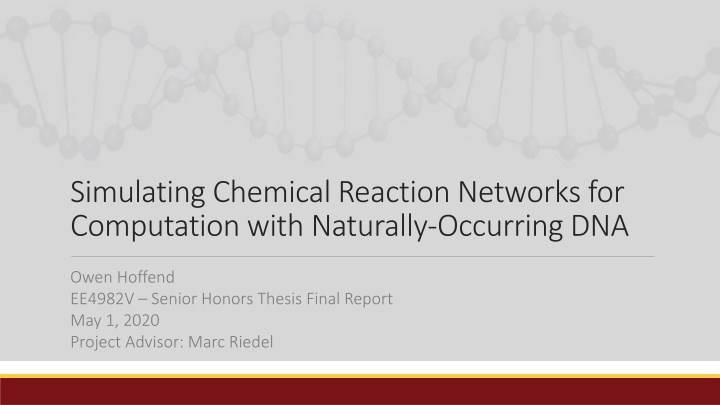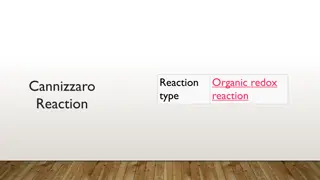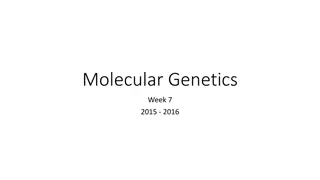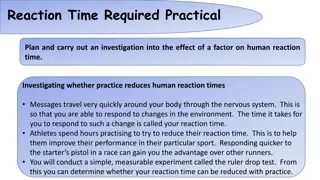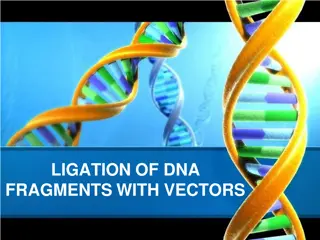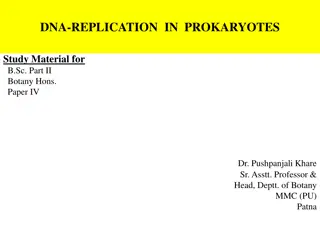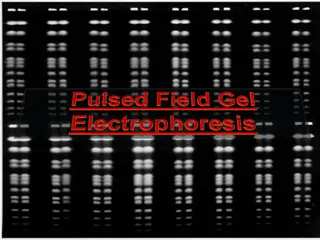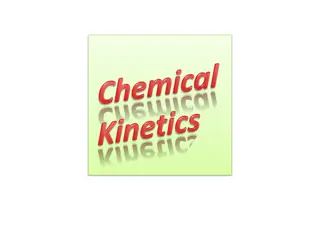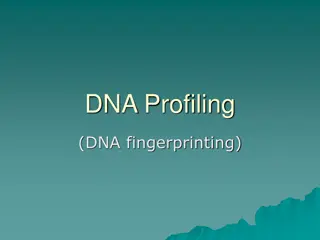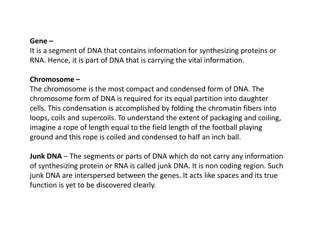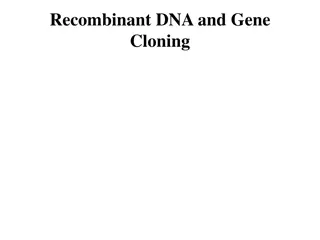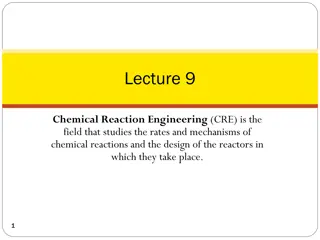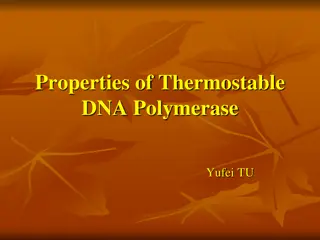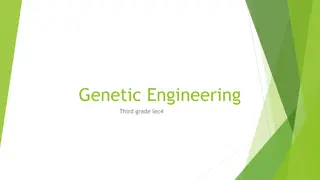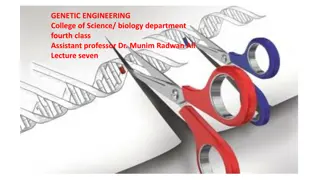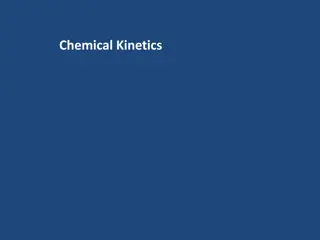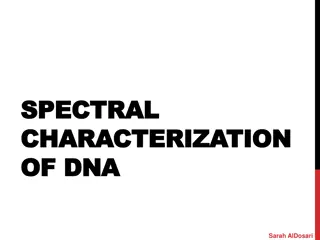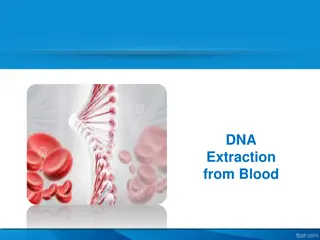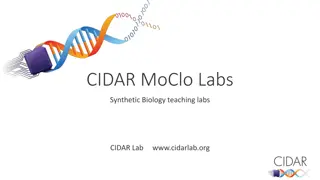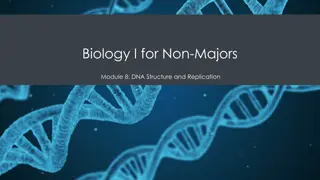Simulating Chemical Reaction Networks for Computation with DNA
This project delves into the realm of molecular computation using DNA, aiming to leverage its potential for highly parallel computation. Explore the background, motivation, and prior work involved in simulating chemical reaction networks to unlock high-performance computing capabilities through naturally occurring DNA. Discover the innovative techniques used in representing data with DNA and operating on this molecular level for computational purposes.
Download Presentation

Please find below an Image/Link to download the presentation.
The content on the website is provided AS IS for your information and personal use only. It may not be sold, licensed, or shared on other websites without obtaining consent from the author.If you encounter any issues during the download, it is possible that the publisher has removed the file from their server.
You are allowed to download the files provided on this website for personal or commercial use, subject to the condition that they are used lawfully. All files are the property of their respective owners.
The content on the website is provided AS IS for your information and personal use only. It may not be sold, licensed, or shared on other websites without obtaining consent from the author.
E N D
Presentation Transcript
Simulating Chemical Reaction Networks for Computation with Naturally-Occurring DNA Owen Hoffend EE4982V Senior Honors Thesis Final Report May 1, 2020 Project Advisor: Marc Riedel
Presentation Overview Background: Molecular Computation with Nicked DNA Project Motivation: Why compute with DNA? Prior Work Project Overview Simulator Design Simulator Software Overview Monte-Carlo DNA Simulation Algorithm Design Results Simulation Results Summary and Conclusion
Project Motivation Why are we interested in molecular computation? Potential to unlock highly parallel computation. Billions of chemical reactions can occur simultaneously. Extremely high data density: DNA is (theoretically) ~4 Exabytes/gram [9]. May unlock significant high-performance computing. Parallel matrix multiply [6]. Parallel arbitrary polynomial functions [7]. Microplates containing many small test tubes for carrying out CRNs [10]. [6] Soloveichik, David, Andy Ellington, Marc Riedel, A. Hernandez, O. Milenkovic, C. Schroeder, and H Zhao. DARPA Review Meeting, Aug. 27, 2019, Follow-up. Presentation. Unpublished. [7] Salehi, Sayed Ahmad, Xingyi Liu, Marc D. Riedel, and Keshab K. Parhi. Computing Mathematical Functions Using DNA via Fractional Coding. Scientific Reports 8, no. 1 (2018). [9] Tabatabaei, S Kasra, Boya Wang, Nagendra Bala Murali Athreya, Behnam Enghiad, Alvaro Gonzalo Hernandez, Jean-Pierre Leburton, David Soloveichik, Huimin Zhao, and Olgica Milenkovic. DNA Punch Cards: Encoding Data on Native DNA Sequences via Nicking. BioRxiv, 2019.
Prior Work Whats been done already? Basic chemical reaction networks (CRNs) [1]: Reactions operating on the concentration of molecules in a solution. Inputs: Concentration of molecules A and B. Output: Concentration of molecule C. Implement CRNs with DNA molecules [8]: Specify [A, T, C, G] pairings to design I/O and reaction behavior. Cascades of strand displacement reactions. PROBLEM: Requires costly DNA Synthesis About $0.12 / eq. binary bit. DNA displacement reaction: [11]. [1] Brijder, Robert. Computing with Chemical Reaction Networks: a Tutorial. Natural Computing 18, no. 1 (2019): 119 37. [8] Soloveichik, D., G. Seelig, and E. Winfree. DNA as a Universal Substrate for Chemical Kinetics. Proceedings of the National Academy of Sciences 107, no. 12 (April 2010): 5393 98.
Representing Data with DNA Low cost solution: Modify existing DNA! Hydroxyl Radical reaction to randomly nick the DNA molecule with probability: Heating causes small sequences of length <k to denature (detach). k=2 in this case. Strand now has exposed bases with probability:
Operating on Data Can operate on the probability Operation: Heating/Cooling the solution to control binding/denaturation. Operation: Mixing different solutions together. All operations are SIMD Can affect many molecules in parallel. Molecular AND gate: Output an exposed base if both inputs have exposed bases. Computes multiplication: ????= ?? ?? Molecular NOT gate: Reverse which bases are exposed/covered. Computes one-minus: ????= ? ?? PROJECT GOAL: Build a simulation program to test/improve this computation scheme.
Implementing Arbitrary Functions Rewrite P(x) in terms of multiply and one-minus operations (known as Horner s Rule) Input Function F(x) Taylor Expansion into Polynomial P(x) Implement with molecular gates See ref. [7] [7] Salehi, Sayed Ahmad, Xingyi Liu, Marc D. Riedel, and Keshab K. Parhi. Computing Mathematical Functions Using DNA via Fractional Coding. Scientific Reports 8, no. 1 (2018).
Simulator Software Overview Python-based simulator software with built-in command line interface. Emphasize ease-of-use to aide research. Input: A file with simple text-based function definitions for the simulator. Example: "funcs":{ "cos" : "(1-x^2/2(1-x^2/12(1-x^2/30))) , } Output: A file containing a table of the simulation results. Optimization: Use of multithreading to improve simulation performance.
Monte-Carlo Simulation Algorithm Traditional simulators for chemical dynamics use a Monte Carlo approach [4]: Start by computing a set of ? potential reactions. Compute the probability of each ?? ? occurring in the next timestep. Randomly sample a reaction ?? ?to fire accordingly. Ways for ?? to occur divided by ways for all reactions to occur. Combinations of molecules that lead to ?? occuring. [4]Gillespie, Daniel T. Stochastic Simulation of Chemical Kinetics. Annual Review of Physical Chemistry 58, no. 1 (2007): 35 55.
Problem with Usual Approach For nicked DNA, finding the set of available reactions ? is computationally intensive. Need to compute possible ways for DNA to bind: 4 Ways to match the sequences in this case. These sequence matching algorithms were prototyped: Brute Force Radix Tree Search Hash Table
Improved Simulation Algorithm Hash table algorithm is ~100x faster than the other two methods. Build hash table (?) as follows: Also includes functions required for molecular gates: Performing random nicking Denaturing Mixing solutions of DNA together
Nick Rate vs. Input Value Relationship Nick rate (x): Rate at which nicks are etched into the molecule. Threshold (k): Represents the heat level applied to the molecule. Input value (y): Ratio of exposed bases to covered bases after heating. Function fit with equation: ? = 1 (1 + ??)(1 ?)? Developed a simple proof of this relationship.
Nick Rate vs. Input Value Relationship Proof based on the probability of base remains covered: . . . . . . Remains covered if: No nick in the prior k bases: OR: At least one nick in the prior k bases, but no nick in the following k bases:
Accuracy of Fundamental Gates Plots of absolute-value error of fundamental gate w/ respect to input value. Average over 25 samples, with DNA length of 10,000 NOT Gate - Max Error: 0.087 AND Gate Max Error: 0.222 NOR Gate Max Error: 0.174
Results Summary & Conclusion DNA-based computation shows promise as a novel method for high-performance parallel computing. Current research is being done on computing on native DNA. Project Motivation Project Goal: Simulate the operation of proposed native DNA computation schemes. A secondary goal was to build a compiler - Command-line interface achieves this partially. Project Goals A custom Monte-Carlo style simulator for modeling DNA computation was built. Simulator provided insight into the mathematics and accuracy of DNA-based computation. Results Design improved molecular gates to reduce error. Conduct physical DNA experiments - Couldn t happen for this project due to COVID. Future Work
References [6] Soloveichik, David, Andy Ellington, Marc Riedel, A. Hernandez, O. Milenkovic, C. Schroeder, and H Zhao. DARPA Review Meeting, Aug. 27, 2019, Follow-up. Presentation. Unpublished [1] Brijder, Robert. Computing with Chemical Reaction Networks: a Tutorial. Natural Computing 18, no. 1 (2019): 119 37. https://doi.org/10.1007/s11047-018-9723-9. [7] Salehi, Sayed Ahmad, Xingyi Liu, Marc D. Riedel, and Keshab K. Parhi. Computing Mathematical Functions Using DNA via Fractional Coding. Scientific Reports 8, no. 1 (2018). https://doi.org/10.1038/s41598-018-26709- 6. [2] Brown, B.d., and H.c. Card. Stochastic Neural Computation. I. Computational Elements. IEEE Transactions on Computers 50, no. 9 (2001): 891 905. https://doi.org/10.1109/12.954505. [8] Soloveichik, D., G. Seelig, and E. Winfree. DNA as a Universal Substrate for Chemical Kinetics. Proceedings of the National Academy of Sciences 107, no. 12 (April 2010): 5393 98. https://doi.org/10.1073/pnas.0909380107. [3] Chen, Tonglin, and Marc Riedel. Parallel Binary Sorting and Shifting with DNA. International Workshop on Bio-Design Automation, July 2019. [4]Gillespie, Daniel T. Stochastic Simulation of Chemical Kinetics. Annual Review of Physical Chemistry 58, no. 1 (2007): 35 55. https://doi.org/10.1146/annurev.physchem.58.032806.104637. [9] Tabatabaei, S Kasra, Boya Wang, Nagendra Bala Murali Athreya, Behnam Enghiad, Alvaro Gonzalo Hernandez, Jean-Pierre Leburton, David Soloveichik, Huimin Zhao, and Olgica Milenkovic. DNA Punch Cards: Encoding Data on Native DNA Sequences via Nicking. BioRxiv, 2019. https://doi.org/10.1101/672394. [5] Jiang, Hua, Sayed Ahmad Salehi, Marc D. Riedel, and Keshab K. Parhi. DiscreteTime Signal Processing with DNA. ACS Synthetic Biology 2, no. 5 (February 2013): 245 54. https://doi.org/10.1021/sb300087n. [10] Image source: https://www.biocompare.com/Lab-Automation-High - Throughput/20123-Microplate-Handling-High-Throughput-Automation/ [11] Image source: http://parts.igem.org/Part:BBa_K1761002:Experience
Collaborators This project is being performed in support of a DARPA-funded collaboration between: University of Minnesota Marc Riedel Circuits and Biology Group University of Illinois, Urbana-Champaign (UIUC) Alvaro Hernandez, Olgica Milenkovic, Charles Schroeder and Huimin Zhao Jean-Pierre Leburton lab, UIUC University of Texas, Austin Andy Ellington and David Soloveichik
